
“One of the things I like about science is that it’s an endless quest. The more you know, the more there is to find out” (Dr Adam Watson)
Dr Adam Watson was an extraordinary man. He spent his life in the mountains and devoted himself to natural science. From the age of 14 he was compiling records of snow patches in the Cairngorms and this was the beginning of a long career spanning zoology, ornithology, meteorology, ecology and conservation, as well as Gaelic place name research.
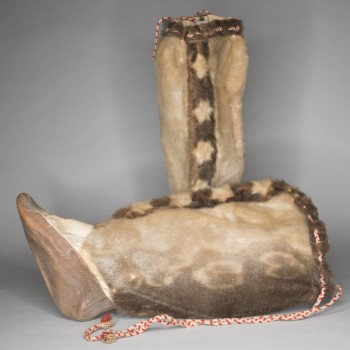
Watson’s connection to Stromness Museum came in 2019, when his daughter Jenny donated his sealskin boots and they became part of our Hudson Bay collection. Her father had bought a pair of ‘kamiik’ (Inuktitut word for sealskin boots) from the Hudson Bay Company store in Pangnirtung, Baffin Island. He was on an Arctic Institute of North America expedition there in 1953.
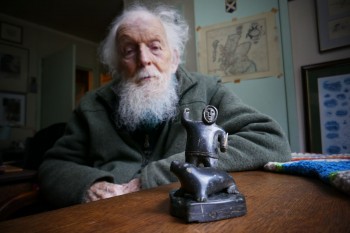
A film was made during the trip, which is available on YouTube https://www.youtube.com/watch?v=kIUWKQRyvJU&t=1520s and is one of the first ever colour films of an Arctic Expedition.
Watson’s boots feature a vertical band of geometric design, typical of men’s sealskin boots from Baffin Island. The soles are made from bearded seal skin, shaved and finely pleated. The vamp (instep) comprises sun bleached dehaired ringed seal skin and the leg ringed seal skin, with the hair left on (information from Jill Oakes, University of Manitoba). These boots were made for cold, dry weather and were often kept for special occasions.
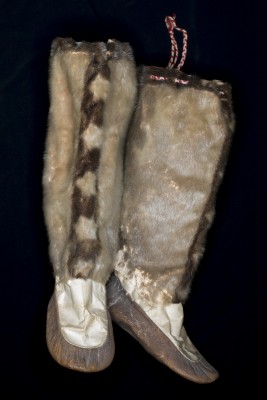
We exhibited the boots in our 2019 winter exhibition: “Carry on Collecting: New Acquisitions”. During preparatory research, I got in touch with Dr Nancy Wachowich, an Anthropologist at the University of Aberdeen who is a co-founder of Mittimatalik Arnait Miqsuqtuit Collective (MAMC) (translation: Pond Inlet Women’s Sewing Collective) in Nunavut, Canada. In the exhibition we featured a video produced by MAMC. The collective was founded in 2015 with the purpose of documenting Inuit sealskin processing and sewing skills and building a new digital archive of films and photographs for use in Nunavut Inuit communities.
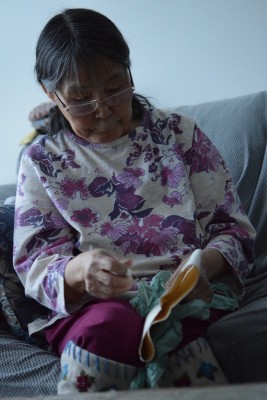
The film we exhibited: Ikpariikutiliqtu: Adding reinforcements showed renowned Inuit seamstress Ruth Sangoya, pictured above, stitching the inner seams of a sealskin kamik. The kamik is being made from a delicate white sealskin, nalua, that has been de-haired, scraped of its fat, and placed outdoors for bleaching and curing during the "frostbite weather" of the dark winter months. Adam Watson’s boots have insteps made of the same material.
Elder sealskin seamstresses in Pond Inlet are keen to share their skills, not just with younger Inuit women apprentice seamstresses, but internationally too. You can view this film and others by the MAMC at: https://vimeo.com/mamc . Their facebook page www.facebook.com/MAMcollective/ is also kept up to date with the latest projects.
It meant a great deal to me to be able to exhibit this film, especially when Sheila Katsak, Nancy’s co-founder at MAMC said:
“it was what the elders wanted: to share in the resilience and beauty of sealskin garment-making internationally”
Remarkably, the connections these boots were making did not end there. I later received a phone call to the museum from a retired teacher in Kirkwall. She had heard from her Inuit family members in Pond Inlet (via facebook) that the MAMC film was being shown in Stromness Museum, and she then came through to see it. Morag’s father Jimmy Smith served with HBC from 1925 until 1936. His first post was Clerk at Pond Inlet and his last position was Post Manager there. He served alongside Jimmy Sinclair from Stromness, who donated numerous objects to the museum.
Several years ago Morag made contact with her half-siblings and their descendants who live there and they now keep in regular contact.
As well as having family in Nunavut, Morag is also a friend of Nancy Wachowich and they meet up annually in Aberdeen.
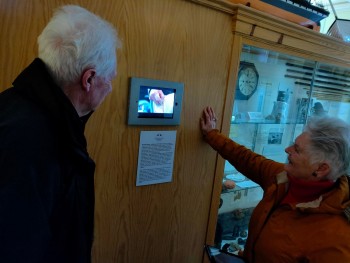
Adam Watson sadly passed away in early 2019, aged 88. In later years he looked back very fondly on his time in the Arctic which he considered the highlight of his life. These boots which hung in front of his writing desk were a constant reminder of the adventures he had there.




